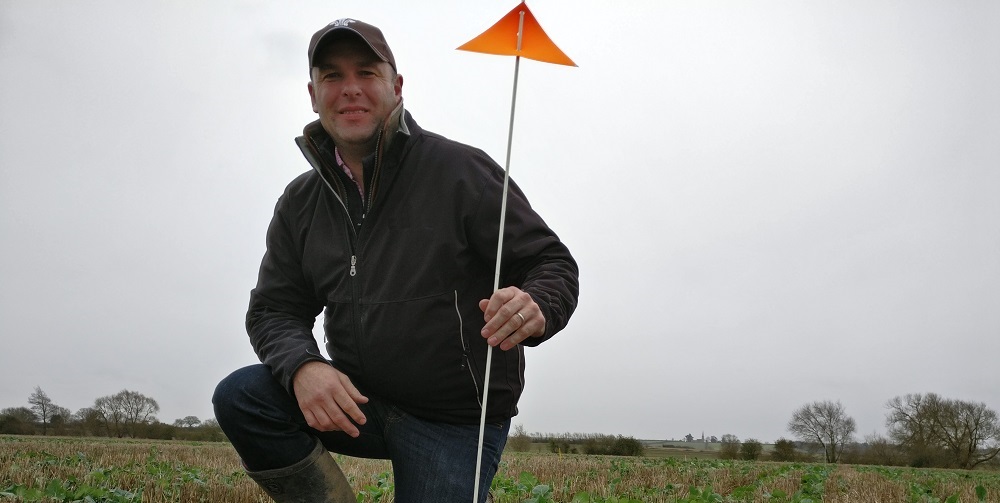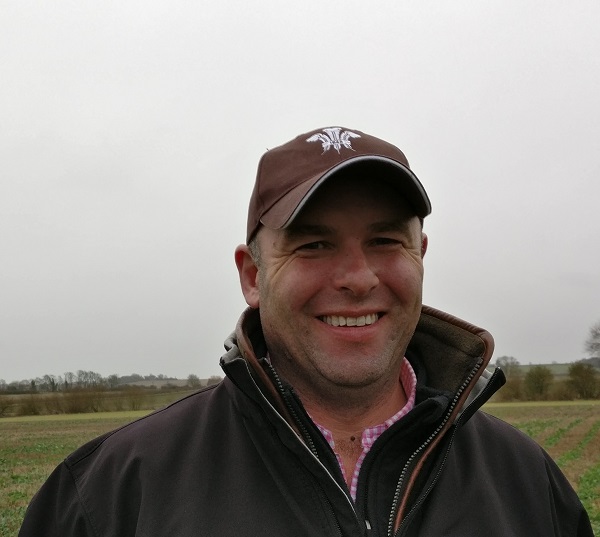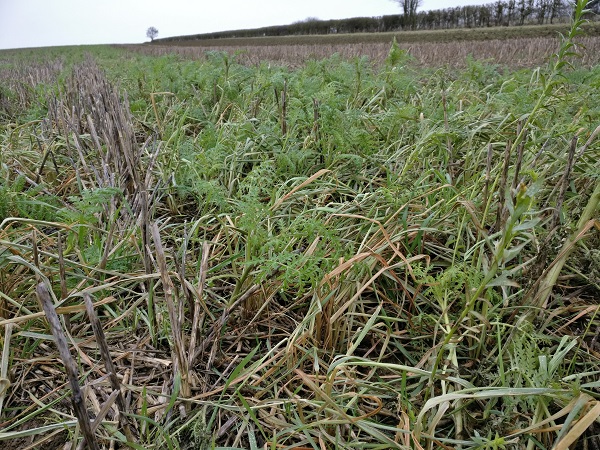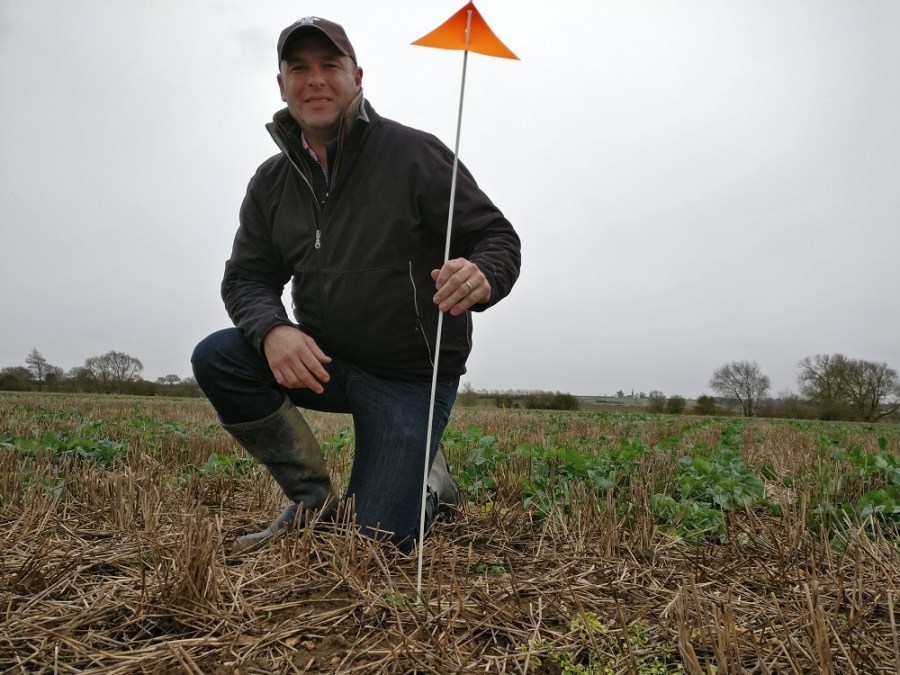
There’s a move afoot to create a network of on-farm trials across the UK. CPM visits one of the first farmers to sign up.
It really puts into perspective what you can achieve if you use the technology right.
By Tom Allen-Stevens
Russell McKenzie is one of those farmers who has an answer to every question. And it’s not just any old answer either – whether it’s variety choice, fungicide strategy or rotation, there’s clearly a lot of thought that goes into his cropping decisions and this just seems to click into place
“I always try to be a couple of steps ahead,” he says, after another deft response to the umpteenth question that’s been fired at him, this time on the use of SDHIs.

Almost a third of the farm is now down to spring crops, and that’s the biggest change the rotation has taken, says Russell McKenzie.
The confidence probably comes from his use of on-farm trials. “You can usually tell from a field corner or telegraph pole what the impact of a spray miss is. What’s more difficult to gauge is the difference between spray programmes,” he explains.
“Local data specific to your own situation is really valuable – I’ve had treated response results of up to 5t/ha, which really puts into perspective what you can achieve if you use the technology right in the right season.”
This year, Russell McKenzie’s become one of the first growers to join BASF’s Real Results Circle that offers support and fungicide products to test in reliable on-farm trials. “It’ll give us the confidence to know what programmes we can use over our entire wheat acreage,” he says.
As manager of John Sheard Farms, he’s responsible for arable cropping over 995ha on the Cambs, Beds and Northants border. There are five blocks over 17 miles, end to end, mostly on heavy clay with the odd bit of “kinder” soil and some gravel. A wheat/oilseed rape-based rotation has been opening up, introducing winter and spring barley and spring beans. Cover crops fill the gaps, and the farm’s moving progressively towards direct drilling, with 200ha now in its first year of complete no-till.
“It’s something we’ve been working towards for the past five years. The main issue has been addressing areas of compaction, and that’s usually just a fault of management – working soils when you shouldn’t,” says Russell McKenzie.

Oat-based cover-crop mixes work well and leave a nice tilth to drill into but they can tie nitrogen up in front of spring barley.
A 6m Horsch Sprinter has been adapted for the no-till role, its Duett coulters swapped out for 25mm Dutch openers. “It’s less horsepower hungry and you’re disturbing less soil, which helps on the blackgrass front. The Sprinter’s not up with the finesse of a a disc drill on the soil-disturbance side, but it’s very good,” he says.
In his third year of cover crops, it’s been disappointing in terms of establishment, as a result of dry conditions. “But we’ve had two good years from the mixes we’ve tried, and we’re beginning to assess their strengths.
“Oat-based mixes work well and leave a really nice tilth to drill into – spring oats, black oats, phacelia, linseed and oil radish-based mixes were the best we used last year. But it can tie nitrogen up in front of spring barley, so we’ve found a mix of phacelia with linseed, peas, buckwheat, sunflowers and radish gives good results.”
Almost a third of the farm is now down to spring crops, and that’s the biggest change the rotation has taken – a move to avoid blackgrass creeping in, says Russell McKenzie. Spring barley varieties comprise Propino (“because maltsters like it”), RGT Planet (“because it yields”) and Explorer (“because the higher N contract suits the heavy land”).
“I don’t like us to rest on our laurels with wheat varieties, so won’t stay wedded to one for long. Skyfall had a disappointing year last harvest, but KWS Siskin and Evolution have proven really consistent. We also have seed contracts for Siskin, Bennington and KWS Kerrin. KWS Crispin was very clean last year and good in the late-drilling slot. Kerrin and Bennington look solid, but I think we’re still searching for that barn-buster.”
Russell McKenzie has hosted variety trials for a number of years. “We looked into whether we could host a trial as an AHDB Monitor Farm as I considered there wasn’t a Recommended List variety trial close enough to give us the local picture, but it proved unsuccessful. That’s when I started discussing hosting trials for BASF with regional manager Jared Bonner.”
There’s a 1ha plot with 26 wheat varieties. It’s managed by BASF, but gives Russell McKenzie the chance to see how they perform in his specific situation, including some varieties he’d never have considered.
He’s also been hosting fungicide trials for several years. “It’s so useful to see how spray programmes compare in our own situation on our own varieties. You can tease out the differences and see the payback,” he notes.
“When you’re spending £90-120/ha on a fungicide programme with wheat at £130/t, you need to be sure you’re clearing a 0.75t/ha benefit. If you’re doing your own trials, you can not only accurately assess the value of a spray programme, but gauge the difference between them, and so confidently pick the best spray programme for your own farm.”
Last year, he compared around eight programmes on a 0.5ha area of KWS Gator. “It’s a fairly disease-susceptible variety and one we’ve grown for a number of years.” The same T0 spray was applied to all, with different T1 and T2 applications and no ear spray. Three treatments of interest were epoxiconazole plus chlorothalonil (CTL) applied twice, this mixture followed by Adexar (epoxiconazole+ fluxapyroxad) and Adexar plus CTL followed by Librax (fluxapyroxad+ metconazole).
“Even the straight azole with CTL gave a 2.5t/ha response over untreated. The two SDHIs gave the biggest response, but it was surprising just how much extra yield just one SDHI delivered.”
Last year, there was also a tramline trial. In one field of Skyfall, across 5ha, four tramlines were given different treatments. Across two of these a BASF programme of Adexar and CTL, followed by Librax was applied. The other two tramlines received Proline (prothioconazole) plus CTL, followed by Aviator Xpro (bixafen+ prothioconazole).
“I didn’t think there’d be much of a difference because Skyfall is a clean variety. But in the end, the BASF programme delivered a 0.5t/ha yield benefit with 9.43t/ha. The entire plot looked clean, so that’s when you start to realise the SDHI is doing more than disease control,” says Russell McKenzie.
There’s quite a lot of “messing around” with tramline trials, he admits. “’I tend to spray them myself as it can be a bit fiddly and surprisingly time consuming to mix up and spray two tramlines in different fields. But it’s worth the time spent to tease out the product data.
“Then you have to weigh the grain accurately at harvest. We calibrate the yield meter before the trial, then I sit in the combine cab while the tramlines are harvested and pick out the information – it’s visual on yield maps, but not specific enough to pick out exact tramline weights. But you only get out of it what you put in.”
This year, the results of the trials will feed into BASF’s Real Results Circle. So what will he put to the test? “There are two new SDHI fungicides I’m keen to try out, but I also want to find an anti-resistance strategy that performs. It’ll be interesting to see what payback you can achieve on a variety with good disease tolerance. And if just one SDHI is used in the programme, we need to find the one that really performs.”
The Real Results Circle
Farming in the UK has never before been confronted with such a perfect storm of uncertainty.
Uncertainty over where the industry is headed post Brexit; uncertainty of returns, because of fluctuating prices and stagnating yields; uncertainty over the removal of chemical active ingredients from the arable toolkit, and uncertainty over which of the mind-boggling array of new products, technologies and tools would be best to try to get to grips with.
To combat growing uncertainty, BASF and CPM invite everyone with a passion for UK farming to unite. We want to help form an agricultural knowledge network of experts, industry specialists, agronomists and farmers.
BASF will be providing technical support and supplying fungicide to 50 growers to help them with on-farm trials to decide which is the best wheat fungicide at T1 and T2. Places have been reserved exclusively for CPM readers.
This year, BASF’s Real Results Circle is looking at wheat fungicides and oilseed rape profitability. This series of articles in CPM profiles some of the growers who’ve joined the Real Results Circle, giving an insight into how they optimise returns from their crops. We’ll also have topical advice and expert guidance from ADAS on how to get the best from on-farm trials.
If you want to find out more and sign up to become part of the BASF Real Results Circle of growers, go to www.basfrealresults.co.uk. To apply for one of the places reserved exclusively for CPM readers, add “CPM” after your name when you sign up.




